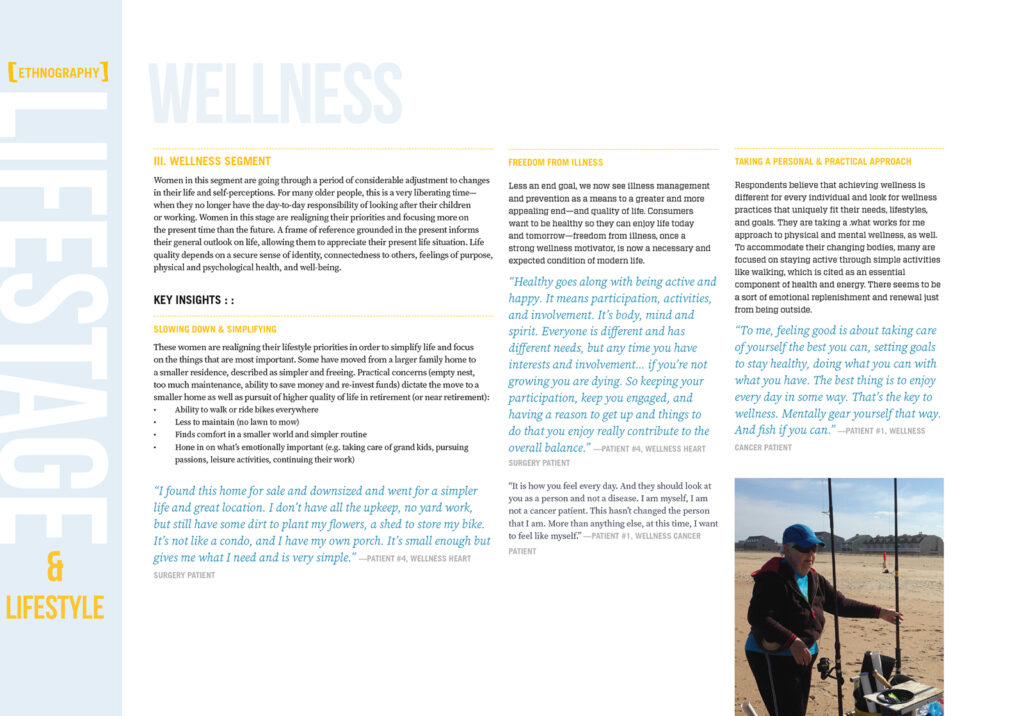The Importance of Cohorts and Personas in Planning Hospital Marketing and Consumer Education Strategies
Hospitals and health systems are increasingly focusing on marketing strategies grounded in healthcare consumer insights to reach and engage with specific patient populations. An important facet of an insights-first marketing practice lies in the use of cohorts and personas—two fundamental marketing tools that allow healthcare marketers to target content and deploy strategies grounded in human understanding and an empathic voice.
While cohorts provide a broader understanding of communities or groups in your market with shared characteristics, personas delve deeper into the nuanced and individual experiences and emotional realities of those within these groups. Together, cohorts and personas form a powerful duo that helps hospital marketers drive marketing ROI while connecting your hospital with your community through the lens of empathy and understanding.
In this article, we explore the fundamental differences between cohorts and personas. We will also explore how the Five Dimensions of Emotional Truth can be leveraged into cohort- and persona-based marketing strategies. And lastly, we will share how insights-first marketing practice can cultivate important financial return on marketing investment (ROMI) while also fueling positive economic outcomes throughout the community you serve.
Understanding the Difference Between Cohorts and Personas
Cohort
Definition: A cohort is a group of individuals who share specific characteristics or behaviors. These characteristics could include demographic factors (age, gender, location), life stage, behavioral patterns (purchasing habits, media consumption), or health-related criteria (chronic conditions, treatment types).
Use in Healthcare Marketing: In the context of hospital marketing, cohorts are used to identify and segment larger groups of people who are aligned in life stage and who might exhibit similar behaviors or characteristics. This segmentation allows healthcare marketers to tailor their strategies to these groups, optimizing resource allocation and messaging. For example, a hospital might identify a cohort of individuals as females in a specific life stage over 60 years old, with a diagnosis of (or are at risk of) diabetes, and who reside in a specific geographic area. Marketing campaigns can then be tailored to address the specific needs and concerns of this cohort of women, leading to efficient use of financial resources and a more effective marketing results.
Persona
Definition: A persona is a detailed, semi-fictional representation of a healthcare stakeholder (patient, caregiver, clinical staff) within a cohort audience. Personas can be built based on both qualitative and quantitative data that includes not only demographic factors (quantitative) but also insights into needs, motivations, fears, hopes, and beliefs (qualitative).
Use in Healthcare Marketing: Personas are essential to accurately target specific types of consumers with healthcare marketing content. Personas play a significant role in improving content strategy, patient engagement, and content relatability. A well-crafted persona will go beyond demographic factors and will champion an understanding of deeper psychological and emotional dimensions. This allows healthcare marketers to develop creative content and strategies that resonate on an individual level. For instance, a persona might represent a specific type of patient, such as “Jane,” a 62-year-old woman managing a chronic condition such as diabetes. Understanding Jane’s healthcare needs and motivations allows the hospital to speak directly to her and patients like her, making the messaging more relevant, engaging, and impactful.
Here are some examples of cohorts for the women’s health service line. Note that there are three cohorts (childbearing, midlife, and wellness). Additionally, you will see specific personas from within each cohort (Tyler, Natalia, and Beatrice). Also, note that these personas also include a low-fidelity “day-in-the-life” map that provides a marketer with additional perspective and helps with targeting .
NOTE: In our next blog, we will dig deep into mapping and how maps can improve marketing outcomes.






Leveraging the Five Dimensions of Emotional Truth Into Cohort and Persona Marketing Strategies
Once a cohort or a persona is identified, the challenge for the healthcare marketer lies in crafting marketing strategies and a content voice that resonates with them and moves them to take action. An insights-first approach—seeking to understand the needs and motivations of stakeholders through a lens of empathy—provides you, the marketing strategist, with a powerful set of tools to craft and deploy relatable messaging that is grounded in the audience’s point of view.
This is where the Five Dimensions of Emotional Truth—needs, motivations, fears, hopes, and beliefs—can come into play. By integrating emotional and psychological insights into the broader understanding of the audience, you will develop more nuanced and effective campaigns.

1. Identifying Common Human Truths
- Step: The first step in leveraging emotional truths is to analyze qualitative insights to identify common patterns across the Five Dimensions. This involves understanding the shared emotional experiences and beliefs within the audience you are targeting—such as common fears related to healthcare, collective hopes for better outcomes, or shared motivations for seeking (or not seeking) care.
- Application: For example, a cohort of patients with chronic conditions might share a common fear of disease progression, while their shared hope could be to maintain a good quality of life. By understanding these patterns, marketing messages can be crafted that speak directly to their concerns and desires.
2. Aligning Needs with Service Offerings
- Step: The next step is to align the identified needs of the cohort with specific healthcare services or solutions offered by your hospital. This alignment should be clear and, most importantly empathic, relating to unique needs and showing how your service meets the audience’s specific needs.
- Application: In the case of Jane, the newly-diagnosed diabetic—if her cohort shares the need for better access to preventive care, your marketing strategy could emphasize how the hospital offers convenient and comprehensive diabetic education and preventive services, directly addressing the audience need.
3. Motivation-Driven Messaging
- Step: Understanding what motivates Jane (and others like her) is crucial in crafting compelling calls to action (CTAs) and messaging. Focusing on what drives her cohort to take action, speaking in a voice that is empathic, and understanding how the healthcare service aligns with stakeholder motivations will significantly enhance engagement.
- Application: For instance, if Jane’s cohort is motivated by the desire to maintain a healthy lifestyle and not to allow diabetes to progress, marketing and education materials could highlight services or products that help them stay active, eat well, and engage in a positive lifestyle. This approach will tap into the intrinsic motivations of the cohort (and individual personas), making them more likely to respond positively.
4. Addressing Fears and Reducing Barriers
- Step: Identifying and addressing the fears prevalent in your audience is another critical aspect of emotional truth-based marketing. Creating strategies to alleviate fears by creating and deploying content that is educational, reassuring, or that showcases success stories, can make a significant difference.
- Application: If your cohort fears the cost of treatment, your marketing strategy might emphasize affordable care options, financial assistance programs, or the long-term value of preventive care. By directly addressing these fears, your hospital marketing strategies can reduce barriers to care and encourage more patients to seek treatment or to engage in positive self-care.
5. Inspiring Hopes Through Positive Outcomes
- Step: Tapping into a cohort’s hopes by showcasing positive outcomes, testimonials, or future-oriented success messaging will align with the stakeholder’s aspirations. This can inspire action and will build trust.
- Application: For a cohort like Jane, hoping to lead a normal life after diagnosis is likely a foundational hope. In this case, your marketing content should focus on positive stories about diabetes, highlighting how your hospital can help patients maintain health and vitality as a diabetic. This positive messaging will resonate deeply with the cohort, making them more likely to trust and choose your hospital for their care.
6. Connecting with Beliefs and Values
- Step: Finally, understanding and respecting the core beliefs and values of a cohort (and related personas) is essential for ensuring that your marketing strategy resonates authentically. This could involve aligning with cultural norms, ethical considerations, or community values.
- Application: If a cohort values holistic and natural approaches to healthcare, your marketing strategy could emphasize your hospital’s integration of traditional and alternative treatments. This alignment with a cohort’s beliefs can build trust and loyalty, making your hospital a preferred choice for care.
Conclusion
In the evolving landscape of healthcare, the ability to connect with patients on both a rational and emotional level is critical to the success of any hospital’s marketing strategy. By understanding and leveraging the differences between cohorts and personas, and by integrating the Five Dimensions of Emotional Truth into your hospital’s marketing and education strategies, your hospital can achieve more than just financial success—you can foster meaningful, long-term relationships with your patients and positively impact the communities they serve.
These strategies not only enhance the effectiveness of marketing campaigns but also align with broader community health needs and goals—contributing to the economic vitality of your community. Hospitals that adopt this approach can expect to see improved patient outcomes, higher engagement, and a more loyal patient base, all of which support sustainable financial growth.
